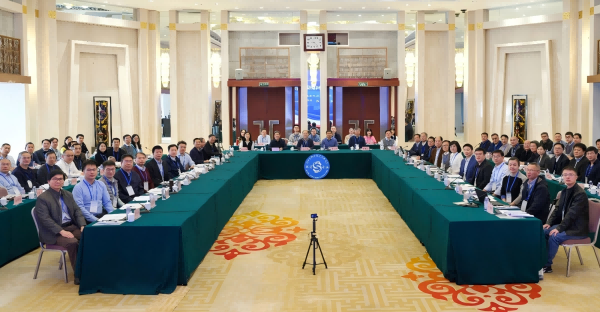From December 5th to 6th, 2024, the 392nd Shuangqing Forum of the National Natural Science Foundation of China (NSFC), titled "Multidisciplinary In-situ Observation Technology System and Formation Mechanism of Very Shallow Source Earthquakes on the Chinese Mainland," was held in Wuhan. This forum was jointly hosted by the Division of Earth Sciences, the Division of Engineering and Materials Science, and the Bureau of Planning and Policy of the NSFC. The forum chairs were jointly held by Academician NI Sidao from the Innovation Academy for Precision Measurement Science and Technology (APM) , Chinese Academy of Sciences, Academician YANG Chunhe from the Institute of Rock and Soil Mechanics, Chinese Academy of Sciences, and Academician XU Yigang from the Guangzhou Institute of Geochemistry, Chinese Academy of Sciences. YAO Yupeng, the Executive Deputy Director of the Division of Earth Sciences and Deputy Director of the Bureau of Planning and Policy of the NSFC, ZHOU Xin, the President of APM, and Academician NI Sidao, the forum chair, delivered speeches at the opening ceremony.
In his speech, Executive Deputy Director YAO Yupeng pointed out that the formation mechanism of earthquakes is a complex systematic scientific issue, and it is urgent to take very shallow source earthquakes on the continent as a breakthrough point, and from the perspective of complex system science, explore how to develop focal research from inversion-based methods to research with in-situ sampling empiricism, controllable experimental verification, and quantitative predictability in the current era of intelligence, thereby constructing an earthquake in-situ observation technology system and deepening research on frontier issues in earthquake science. He hoped that the participating experts would speak freely and, through the collision of ideas and multidisciplinary intersections, jointly condense the major frontier scientific issues in this field and provide important references for the strategic layout and future development of the science fund in this field.
In his speech, President ZHOU Xin introduced the research achievements of tapm in recent years. He expressed the hope that through this forum, exchanges and learning with domestic peers could be strengthened to jointly promote the intersection of earth sciences with atomic physics and molecular chemistry and contribute to enhancing the intelligence of earthquake science research.
Academician NI Sidao delivered a speech on behalf of the forum chairs, introducing the main purpose, organizational form, and characteristics of this forum. He expressed the hope that every participating expert would actively speak up, put forward their unique insights, and jointly contribute ideas and suggestions for overcoming the difficulties in earthquake research to promote the innovative development of earthquake mechanism research in China.
This forum arranged one plenary report and four keynote reports, with 12 special reports arranged around three topics: "The Initiation and Termination Processes and Fine Structure of Source Zones of Very Shallow Source Earthquakes on the Continent," "Frontier Technologies for In-situ Observation and Analysis of Very Shallow Source Earthquakes on the Continent," and "Formation Mechanism of Very Shallow Source Earthquakes on the Continent." During the discussions, the participating experts believed that this forum took very shallow source earthquakes on the continent as a breakthrough point to explore and condense the important scientific and technological issues that urgently need attention and resolution in the multidisciplinary in-situ observation technology system and formation mechanism of continental earthquakes, and proposed suggestions for empirical research on focal processes, which will effectively deepen frontier research in earthquake science and effectively serve the country's major needs for earthquake prevention and disaster reduction.
Fifty experts and scholars from universities and scientific research institutes across the country, including Academician ZHANG Peizhen, Academician CHEN Xiaofei, Academician SUN Youhong, and Academician PAN Yishan, as well as FAN Yingjie, the Deputy Director of the Bureau of Planning and Policy of the NSFC, and staff from relevant departments participated in this forum. Representatives of the heads of youth science fund projects and representatives of the heads of youth student basic research projects (outstanding doctoral students) were invited to attend. (Contributed by ZHAO Qian and CHENG Huihong from the Division of Earth Sciences, and LI Minglu and LUO Yi from the Bureau of Planning and Policy)

the meeting scene
